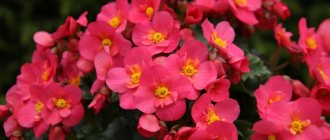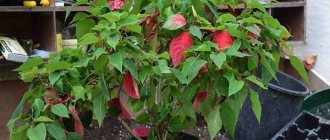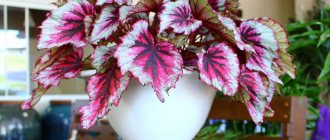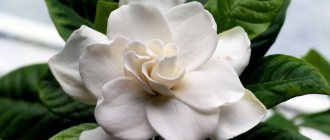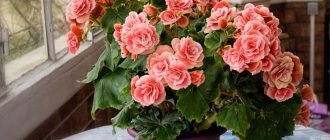Begonia - flower features
The leaves have an asymmetrical beveled appearance. They can be whole or cut into several pieces with soft or jagged edges. For most, the side of the leaf facing the ground is dominated by various shades of red and purple. Flower collectors who love to grow unusual houseplants are especially sensitive to specimens decorated with geometric patterns, strokes, and dots. In some species, the surface of the stem and leaf is fluffy and soft due to many small villi. Strong and dense stems protect against pests and other mechanical damage. The fruit of begonia is a capsule, the seeds are very small. How begonia reproduces is described in the scientific works of reputable scientists.
Classification of begonias according to various characteristics
Scientists have not agreed on the systematization of plants by characteristics, and in English and domestic sources there is an absolutely diverse division by type. What is important for flower growers to know is that the care for these plants and the conditions for their cultivation are the same and may differ only slightly:
- decorative deciduous begonias;
- bush begonias;
- tuberous begonias;
- beautiful flowering begonias.
Decorative deciduous begonias
The usual stem is absent, and elongated, flowing leaves begin to grow directly from the branched root. They are valued for the beauty of their leaves, which have a variety of shapes and colors. Olive-green, brown-pink, purple, violet, dark gray, with a silver coating and a cuff of fibers - a wide range of colors to suit every taste for connoisseurs of house plants. It is worth noting the propagation of begonia by leaf as the simplest way to add this flower to your collection of green friends.
Representatives:
- royal begonia;
- Metallica;
- brindle or Bauer.
Shrub begonias
It differs from the previous species in size and densely growing needle-like branches. The exquisite and sophisticated inflorescences of this plant become the main decoration of garden flower beds around a dacha or country house. The root is reduced into a tuber without division into small segments. Bush from 15 cm to 180 cm. They can be annual, when the life cycle takes place in the shortest possible time within one year, as well as perennial, requiring transplantation into containers, since a drop in temperature can cost them their lives.
Popular among flower growers are:
- coral begonia;
- fuchsia.
Tuberous begonias
Due to the tubers, the plant calmly survives low temperatures and dry summer periods. Thanks to the root, the flowering period of begonia is long and can vary from four months to six months. Representatives of the species are herbaceous, shrubby and hanging. The color of the leaf cannot boast of variety and usually contains all shades of green.
Diseases and pests
Tuberous begonia is considered a strong plant and resistant to most diseases, but the owner will still have to remember something.
- Most often, tuberous begonia (and other varieties) are affected by mold. The cause may be an infection, but mainly this trouble occurs due to non-compliance with the level of humidity in the room. When gray, slightly damp spots appear on the leaves, think about whether you ventilate the room often enough and whether you are watering your pet too much? By the way, mold is dangerous not only for home greenery, but also for people living in the apartment.
- Powdery mildew is another consequence of high humidity and too generous watering. A whitish powdery coating appears on the ground part of the flower, which cannot be scraped off with a finger, and only a fungicide, “Benomil” or something similar, will help get rid of it.
- Gray rot, like powdery mildew, affects leaves and stems, but the coating is not white, but gray. The plant must be urgently moved to a drier and cooler place and treated with a fungicide.
- Black rot appears on the root system and, unfortunately, is most often discovered late, when the affected area is large and nothing can be done (during replanting, for example). If the disease has just begun, cut off the damaged roots, treat with a fungicide and replant the plant in fresh soil.
- The red spider mite appears in a warm and humid atmosphere: the leaves become marbled in color, then turn yellow and fall off, the stems become entangled in cobwebs. And all this happens in a very short period of time. The drug "Decis" will help to cope with insects: the plant is sprayed with it several times, paying special attention to the back side of the leaves - mites settle there.
- The whitefly feeds on cell sap, biting through the leaves, which is why the plant stops growing, turns yellow and withers. Try spraying the begonia with a solution of soap (dilute 40 g of laundry or tar in 10 liters of heated water), making sure that the solution does not get on the roots. If the recipe doesn’t help, buy Fitoverm or Actellik.
- The nematode is the most dangerous of all pests. First of all, because it is not visible, since it settles in the ground and practically does not come to the surface. When the owner notices that the roots of the flower become thick, grape-shaped, and full of larvae, not a single insecticide will help save the plant. The only thing you can do is carry out the propagation procedure and grow a new specimen.
The procedure for treating plants with chemicals and other preparations to get rid of insects requires compliance with a number of conditions. First, don't allow children, pet dogs, or cats to hang around. Secondly, arrange ventilation after work. And thirdly, do not neglect gloves, goggles and a pharmaceutical mask to protect your respiratory organs, eyes and skin.
What other difficulties may arise when growing tuberous begonia?
- If the begonia's buds suddenly fall off during the budding period, it means that you disturbed it at this time: either you moved the pot to another place, watered it incorrectly, or stopped feeding it.
- Yellow leaves indicate soil depletion, lack of water, or the appearance of a dangerous pest.
- Why doesn't it bloom? The reasons may be different: soil depletion, lack of light or water, drafts, incorrectly chosen fertilizers, pests. All you have to do is analyze your actions and adjust your care.
The active life span of tuberous begonia is only 5-6 years. If the plant has exhausted its resource, nothing will help.
General information on how garden begonia propagates
You can always find an option to preserve and increase the number of begonias; we will consider how to propagate it further.
Note! Begonia should absolutely not be left to overwinter in a flower bed. The delicate plant will not tolerate a drop in temperature.
In order to enjoy tuberous begonia, which can be propagated in 4 ways, for as long as possible, you need to know the rules of transplantation and propagation.
You can reproduce in the following ways:
- vegetative;
- seeds;
- tubers;
- leaf or stem shoots.
Begonia propagation by seeds
Spring is the most comfortable time of year to germinate begonias, and then you will get abundant flowering with the onset of autumn. The plant is very light-loving. The sown seeds do not need to be covered with soil; they must germinate in the light. To sow seeds, you can take any plastic container. The soil must be well sifted; for this, a production sieve is used.
Note! If you are not sure of the quality of your soil substrate, you can spill it with potassium permanganate. This should only be done after you have wet it with water.
To make propagation comfortable for the begonia flower, you should pay attention to some aspects. Infected crops do not allow individual plants to form and they are stunted in growth. With the correct concentration of seeds, about 300 units can be grown in a small 15x20 cm container. When sowing is completed, cover the container with a transparent lid and place it in a bright place.
Begonia germinates in about 14 days. Do not allow the soil to dry out or become waterlogged; use a spray bottle for watering. Comfortable temperature at the first stage of germination is +20-22 ℃, it is advisable to maintain it throughout the day. After the first shoots, the temperature can be reduced. Next, we’ll look at when and how to plant begonias. We do this when not the first cotyledon leaves appear, but when one or two pairs of real leaves, similar to adults, are formed. We begin to plant the sprouts in separate pots.
Propagation of flowers by cuttings
Step-by-step instructions on how to root begonia cuttings.
How to cut and prepare cuttings
Cuttings from begonias do not require any special techniques, so we do it the classic way. We take pruning shears and cut off a small shoot of the plant with two to four leaves; any that are too long can be shortened. Do not prune too much so that the process of photosynthesis does not stop and substances get into the growing point. If there is a flower left on the cutting, it must be removed.
What should the vessel and water be like?
An important step is the choice of water for root germination. If you want to root a cutting well, then using tap water is a bad idea.
Note! Tap water is different everywhere. It can be soft and hard, contain various impurities - all of this has a detrimental effect on the life of the plant. Therefore, it is better to filter the water and only then put the cutting in it.
Preparation of planting material
How to properly plant a begonia cutting? Initially, it is necessary to select good planting material. Cuttings can be taken from the top of the bush or from side shoots. Usually it is possible to collect a lot of planting material when pruning a bush. Begonias are considered very tenacious, so for rooting they actually need only one growth point (leaf or bud on a branch). But it’s better if there are 3-4 of them. Therefore, cuttings are made 15-20 cm long, with an oblique cut at the bottom. The bottom leaf is cut off completely, a third is cut off from the top ones so that the leaf plates do not absorb a lot of vital juices.
For leaf cuttings, select leaves that are strong, without signs of disease, yellowing, or wilting, with developed veins.
There are two main ways to root begonia from cuttings - in water or soil. They are considered to be equivalent. But when planting in water, cuttings need to be prepared with a reserve, since some will certainly be lost. In addition, there is an opinion that when planted directly into the ground, healthier and stronger plants are obtained.
Methods for propagating begonia by leaf
Flower growers will be interested to know how the begonia flower reproduces by leaf. Adult, well-formed leaves with clearly defined veins are suitable for this method. Take a leaf, turn it over, and use a thin sharp blade to make cuts across the veins. The propagation sheet is ready. Fill a plastic glass or any other container with the prepared soil mixture. For faster results, you can add phytosporin to the water and moisten the soil by spraying. Place the sheet on top of the ground with the cut veins down, press it on top with a pebble, an eraser, or secure the sheet with a paper clip. Make a greenhouse by covering the glass with a transparent lid or bag.
In water
Using a sharp blade, carefully cut off an adult begonia leaf. Prepare purified filtered water in advance, pour it into a transparent glass so that the leaf petiole goes under water no more than 2 cm. Make sure that the growing point is not recessed. Such cuttings take root within a week, and after two weeks you can confidently plant a leaf in the substrate.
Sheet division
An interesting unusual way of propagating begonias by dividing a large leaf into fragments. Such leaves are not viable, but they can produce offspring. Remove the petiole and use a blade or scalpel to cut the leaf into several segments. Place each piece of leaf vertically into the ground so that the base of the large vein is buried in the ground.
Propagation of plants by tubers
Let's look at how to propagate tuberous begonia starting in winter. Preservation of begonia tubers should be done in the fall; wintering takes place in a warm place without temperature changes. If stored properly, you will find young buds and even shoots in the spring. First you need to carefully examine the tuber and mentally divide it into parts so that the buds and shoots are preserved, 2-3 of each. After cutting the tuber, the cut site must be treated to prevent rotting. Ash, charcoal, and brilliant green are suitable for processing. After the cutting lines have dried, the tubers can be planted in open ground.
Landing
You need to pour a mixture of perlite (sand) and peat into a plastic cup, spill it, wait until the moisture is evenly distributed.- The cuttings are dipped in water; it is also possible to use stimulating drugs such as root. Then stick it into the ground 2-3 cm, lightly pressing the soil with your fingers.
- Then cover the container with a jar, glass or bag. Place the mini-greenhouse with the cuttings in a warm, illuminated place.
How to care for a flower
You need to properly care for a flower if you want it to delight you with its flowering.
Transplanting and pinching
The formation of a bushy plant to obtain a decorative appearance occurs through pinching. The first sanitary pruning is carried out when the flower reaches 8-10 cm in height. Flower growers usually use two methods for forming a lush bush: pinching (removing the top part of young shoots), pruning (shortening old shoots by half).
Important! Young flowers should not be pruned, otherwise the plant will continue to have a tendency to shrink and increase the volume of foliage.
Flowers require replanting every year. It is better to use wide, low pots, because the rhizome has many adventitious and lateral roots. Be sure to place drainage at the bottom of the pot.
Fertilizing the plant
In order for the plant to feel comfortable and enjoy its growth, it is necessary to choose the right soil at the planting stage. The best mixture for begonias is one that contains coniferous, beech, deciduous soil, a little river sand and charcoal. Additionally, you can use professional fertilizer from an agricultural store. In this case, fertilizing should be done once every two weeks.
Watering mode
A comfortable watering period is usually once every 5-7 days. If the room is cool, you can take slightly warmed water. Regular loosening of the soil after watering has a positive effect on the plant.
Possible problems
- Once again I would like to draw your attention to the fact that when planting there must be a drainage layer. It will help the plant with possible overwatering. The liquid should flow out of the pot easily.
- After drainage, the next layer is charcoal, which will prevent the development of gili.
- At the first suspicion of a flower disease, it needs to be treated with special preparations. You will learn about diseases and pests of begonia, as well as why the plant does not bloom here.
- Then move the container with the plant to a ventilated room, away from healthy flowers.
- If you see rot on a cutting in water, you should remove it from the water. Cut off the rotten part and place in a container with fresh water. The plant may have become infected with a fungal infection.
- If the shoots begin to turn black.
This may be due to the fungal disease gray mold. It develops in a cool and damp room. Important! To save young shoots, you should treat them with a fungicide, and regularly ventilate and heat the room. - The sprouts stretch out, becoming long and thin. The plants clearly do not have enough sunlight. If possible, it is worth moving them closer to the light source.
- Leaves turn yellow and curl. Perhaps the plants do not have enough moisture or the room is hot. To improve the growth process, you should review the watering regime and lower the air temperature.
- Slow growth. Perhaps the young plant does not have enough nutrients in the soil, so it should be fed with fertilizers.
I would also like to note that cuttings produce many seedlings. You can give them to your loved ones, family, friends. Let their home also be beautiful and colorful with bright flowers. Tell me how to care for and breed.

